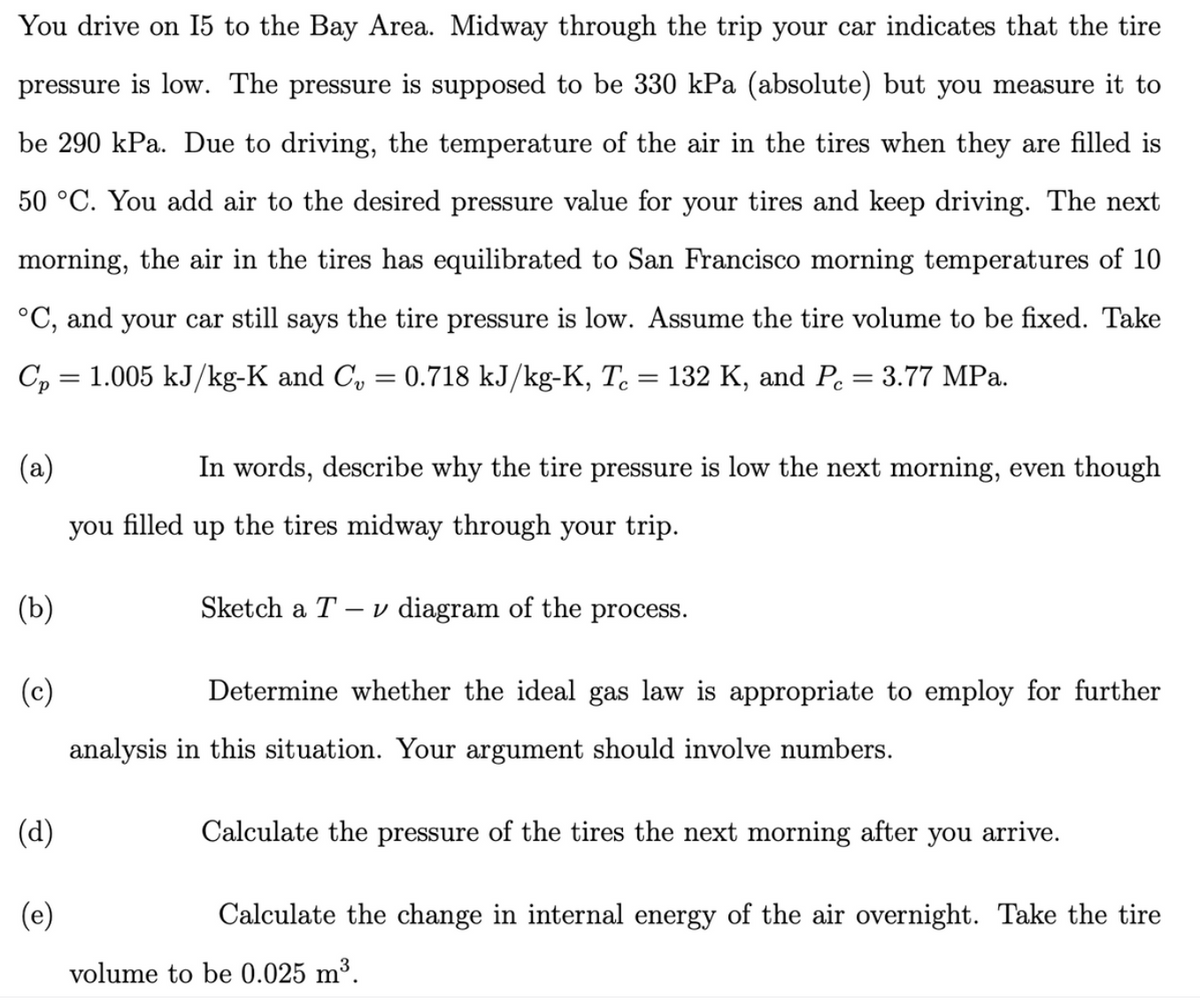You drive on 15 to the Bay Area. Midway through the trip your car indicates that the tire pressure is low. The pressure is supposed to be 330 kPa (absolute) but you measure it to be 290 kPa. Due to driving, the temperature of the air in the tires when they are filled is 50 °C. You add air to the desired pressure value for your tires and keep driving. The next morning, the air in the tires has equilibrated to San Francisco morning temperatures of 10 °C, and your car still says the tire pressure is low. Assume the tire volume to be fixed. Take 132 K, and P = 3.77 MPa. Cp 1.005 kJ/kg-K and C₁ = 0.718 kJ/kg-K, Tc (b) (c) = (a) you filled up the tires midway through your trip. (d) (e) = In words, describe why the tire pressure is low the next morning, even though Sketch a T - v diagram of the process. Determine whether the ideal gas law is appropriate to employ for further analysis in this situation. Your argument should involve numbers. Calculate the pressure of the tires the next morning after you arrive. Calculate the change in internal energy of the air overnight. Take the tire volume to be 0.025 m³.
You drive on 15 to the Bay Area. Midway through the trip your car indicates that the tire pressure is low. The pressure is supposed to be 330 kPa (absolute) but you measure it to be 290 kPa. Due to driving, the temperature of the air in the tires when they are filled is 50 °C. You add air to the desired pressure value for your tires and keep driving. The next morning, the air in the tires has equilibrated to San Francisco morning temperatures of 10 °C, and your car still says the tire pressure is low. Assume the tire volume to be fixed. Take 132 K, and P = 3.77 MPa. Cp 1.005 kJ/kg-K and C₁ = 0.718 kJ/kg-K, Tc (b) (c) = (a) you filled up the tires midway through your trip. (d) (e) = In words, describe why the tire pressure is low the next morning, even though Sketch a T - v diagram of the process. Determine whether the ideal gas law is appropriate to employ for further analysis in this situation. Your argument should involve numbers. Calculate the pressure of the tires the next morning after you arrive. Calculate the change in internal energy of the air overnight. Take the tire volume to be 0.025 m³.
Elements Of Electromagnetics
7th Edition
ISBN:9780190698614
Author:Sadiku, Matthew N. O.
Publisher:Sadiku, Matthew N. O.
ChapterMA: Math Assessment
Section: Chapter Questions
Problem 1.1MA
Related questions
Topic Video
Question

Transcribed Image Text:You drive on 15 to the Bay Area. Midway through the trip your car indicates that the tire
pressure is low. The pressure is supposed to be 330 kPa (absolute) but you measure it to
be 290 kPa. Due to driving, the temperature of the air in the tires when they are filled is
50 °C. You add air to the desired pressure value for your tires and keep driving. The next
morning, the air in the tires has equilibrated to San Francisco morning temperatures of 10
°C, and your car still says the tire pressure is low. Assume the tire volume to be fixed. Take
C₂ = 1.005 kJ/kg-K and C₂ = 0.718 kJ/kg-K, T = 132 K, and Pc = 3.77 MPa.
(a)
In words, describe why the tire pressure is low the next morning, even though
you filled up the tires midway through your trip.
(b)
(c)
(d)
(e)
Sketch a T - v diagram of the process.
Determine whether the ideal gas law is appropriate to employ for further
analysis in this situation. Your argument should involve numbers.
Calculate the pressure of the tires the next morning after you arrive.
Calculate the change in internal energy of the air overnight. Take the tire
volume to be 0.025 m³.
Expert Solution
This question has been solved!
Explore an expertly crafted, step-by-step solution for a thorough understanding of key concepts.
This is a popular solution!
Trending now
This is a popular solution!
Step by step
Solved in 3 steps with 2 images

Knowledge Booster
Learn more about
Need a deep-dive on the concept behind this application? Look no further. Learn more about this topic, mechanical-engineering and related others by exploring similar questions and additional content below.Recommended textbooks for you

Elements Of Electromagnetics
Mechanical Engineering
ISBN:
9780190698614
Author:
Sadiku, Matthew N. O.
Publisher:
Oxford University Press

Mechanics of Materials (10th Edition)
Mechanical Engineering
ISBN:
9780134319650
Author:
Russell C. Hibbeler
Publisher:
PEARSON

Thermodynamics: An Engineering Approach
Mechanical Engineering
ISBN:
9781259822674
Author:
Yunus A. Cengel Dr., Michael A. Boles
Publisher:
McGraw-Hill Education

Elements Of Electromagnetics
Mechanical Engineering
ISBN:
9780190698614
Author:
Sadiku, Matthew N. O.
Publisher:
Oxford University Press

Mechanics of Materials (10th Edition)
Mechanical Engineering
ISBN:
9780134319650
Author:
Russell C. Hibbeler
Publisher:
PEARSON

Thermodynamics: An Engineering Approach
Mechanical Engineering
ISBN:
9781259822674
Author:
Yunus A. Cengel Dr., Michael A. Boles
Publisher:
McGraw-Hill Education

Control Systems Engineering
Mechanical Engineering
ISBN:
9781118170519
Author:
Norman S. Nise
Publisher:
WILEY

Mechanics of Materials (MindTap Course List)
Mechanical Engineering
ISBN:
9781337093347
Author:
Barry J. Goodno, James M. Gere
Publisher:
Cengage Learning

Engineering Mechanics: Statics
Mechanical Engineering
ISBN:
9781118807330
Author:
James L. Meriam, L. G. Kraige, J. N. Bolton
Publisher:
WILEY